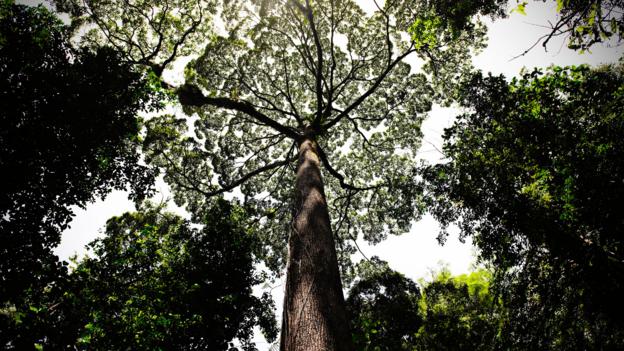While sustainable forestry techniques could reduce rainforest deforestation by millions of acres per year, travellers can also play their part.
By 2020,
palm oil plantations in Indonesian Borneo will emit more than 600 million tons
of carbon dioxide – more than the entire fossil fuel emissions from Canada. This
figure comes from a study in
the scientific journal Nature Climate Change, which reports that about
one-third of Indonesian Borneo’s lowland rainforests will be deforested for palm
oil production in the coming decade.
Rainforests are natural “carbon sinks”, absorbing carbon dioxide during photosynthesis and creating a significant line of defence against climate change. So the environmental impact of Borneo’s deforestation for industrial purposes is two-fold: the clearing of forests reduces the absorption of carbon dioxide and the subsequent production of palm oil releases mass emissions of the same harmful gas.
Rainforests worldwide are currently being cleared at a rate of 1.5 acres per second, according to the international environmental organisation Greenpeace. If deforestation continues at this speed, all of the world’s rainforests could be wiped out entirely in less than 100 years. Considering that more than half of the world’s plants and animals live in rainforests, the implications are grave.
The relationship between rainforests and climate change is also highly symbiotic. Not only does deforestation reduce the amount of carbon dioxide that a rainforest can absorb, but an unexpected weather event, such as a drought (which some scientists believe may itself be a result of climate change), can actually reverse a rainforest’s role, causing it to emit carbon dioxide rather than absorbing it.
The latter phenomenon is what happened in 2005 when the Amazon rainforest was hit by a serious drought. As trees died off, the Amazon released between 1.2 billion and 1.6 billion tons of carbon dioxide, according to the scientific journal Nature. Contrast that with a typical year, during which the world’s rainforests consume around 1.3 billion tons of carbon dioxide per year – about one-fifth of the world’s fossil fuel emissions.
Some parts of the world are faring better than others, though. An international conference held at the University of Oxford this year found that African rainforests are more resilient in the face of climate change than those in South America or Southeast Asia. African forests have experienced a more variable climate over the past 10,000 years and endured several natural disasters over the past 4,000 years. The species that have persevered, scientists say, are adaptable to sporadic changes in rainfall.
While sustainable forestry techniques -- such as selectively culling trees rather than clear-cutting whole areas of forests -- could reduce deforestation of rainforests by millions of acres per year, according to National Geographic, travellers can also play their part. There are several volunteer projects that allow people to visit the rainforests while also helping to save them – including reforestation efforts in Borneo, Brazil and Ecuador, in which volunteers replant trees, build forest trails and study disappearing species -- and volunteers with the Earthwatch Institute are working with scientists to figure out why frog species are vanishing from Australia’s rainforests.
Rainforests are natural “carbon sinks”, absorbing carbon dioxide during photosynthesis and creating a significant line of defence against climate change. So the environmental impact of Borneo’s deforestation for industrial purposes is two-fold: the clearing of forests reduces the absorption of carbon dioxide and the subsequent production of palm oil releases mass emissions of the same harmful gas.
Rainforests worldwide are currently being cleared at a rate of 1.5 acres per second, according to the international environmental organisation Greenpeace. If deforestation continues at this speed, all of the world’s rainforests could be wiped out entirely in less than 100 years. Considering that more than half of the world’s plants and animals live in rainforests, the implications are grave.
The relationship between rainforests and climate change is also highly symbiotic. Not only does deforestation reduce the amount of carbon dioxide that a rainforest can absorb, but an unexpected weather event, such as a drought (which some scientists believe may itself be a result of climate change), can actually reverse a rainforest’s role, causing it to emit carbon dioxide rather than absorbing it.
The latter phenomenon is what happened in 2005 when the Amazon rainforest was hit by a serious drought. As trees died off, the Amazon released between 1.2 billion and 1.6 billion tons of carbon dioxide, according to the scientific journal Nature. Contrast that with a typical year, during which the world’s rainforests consume around 1.3 billion tons of carbon dioxide per year – about one-fifth of the world’s fossil fuel emissions.
Some parts of the world are faring better than others, though. An international conference held at the University of Oxford this year found that African rainforests are more resilient in the face of climate change than those in South America or Southeast Asia. African forests have experienced a more variable climate over the past 10,000 years and endured several natural disasters over the past 4,000 years. The species that have persevered, scientists say, are adaptable to sporadic changes in rainfall.
While sustainable forestry techniques -- such as selectively culling trees rather than clear-cutting whole areas of forests -- could reduce deforestation of rainforests by millions of acres per year, according to National Geographic, travellers can also play their part. There are several volunteer projects that allow people to visit the rainforests while also helping to save them – including reforestation efforts in Borneo, Brazil and Ecuador, in which volunteers replant trees, build forest trails and study disappearing species -- and volunteers with the Earthwatch Institute are working with scientists to figure out why frog species are vanishing from Australia’s rainforests.
























0 comentários:
Postar um comentário